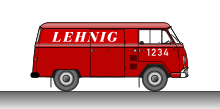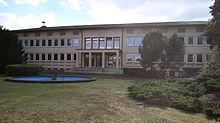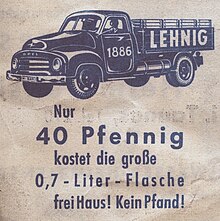Quellen-Lehnig
| Quellen-Lehnig AG
|
|
|---|---|
| legal form | Corporation |
| founding | 1952 |
| resolution | January 1978 |
| Seat | Eschwege |
| management |
Chief Executive Officer : • Wolfgang Lehnig (1952–1965) • Dr. Henke (from 1965) • Leo Wiedemann (≈ 1974) Insolvency administrator : • Rolf Herrmann (1977/1978) |
| Number of employees | 2300 (October 1968) |
| sales | • 500,000 D-Mark (1953) • 70 million D-Mark (1961) • 82 million D-Mark (October 1968) • "almost 100 million D-Mark" (late 1960s) |
| Branch | Beverage industry |
Coordinates: 51 ° 11 '47.55 " N , 10 ° 1' 4.14" O

The source Lehnig AG was a mineral well-established company headquartered in the north Hessian town of Eschwege . In the post-war period during the economic miracle , the company had great success with its innovative sales concept of delivering mineral water to private customers - and later also lemonade and beer - free of deposit , and achieved nationwide fame.
history
prehistory
Wolfgang Lehnig (1908–1988) studied at the Handelshochschule Berlin and exercised various professions after graduating. Among other things, he worked as a restaurant receptionist, operator of a lending library and lottery collector; In addition, he traded in knitting wool, made handicrafts and was a manufacturer of ceramic plates . After the Second World War , he made garters from the ribbons from respiratory masks . However, the currency reform of 1948 ruined his business.
Beginnings
After the bankruptcy, Lehnig still owned two trucks, which he used as a basis for realizing his new business idea. Initially, he procured the representation of 16 West German medicinal water springs and delivered their water within a 150 kilometer radius of Göttingen at the customary price. Business was slow, however. At times, up to 20,000 boxes were stored at the customer's because he lacked the financial means to pay the employees who were supposed to collect the empties. At the same time, however, he could not do without these bottles, as they represented important capital. He then conducted an extensive survey of his dealers and sales drivers in order to find out under what conditions customers would be willing to buy more water than before. He put these customer requests together in a list. The most frequently mentioned points were:
- It would be more pleasant not to have to pay a bottle deposit any more.
- The green glass makes it difficult to see the contents of the bottle.
- The crown caps used have the disadvantage that you can only open the bottles once and the contents then become stale.
Lehnig responded to the wishes. He waived the deposit for customers, removed all green glass bottles from his range and introduced so-called patent lever closures. The company soon became more and more successful - in 1953, for example, sales were already 500,000 Deutschmarks. However, it was not until 1955 that the company was profitable with 100 delivery vehicles. Before that, Lehnig, who henceforth referred to his niche in the market as "beverage home service", had problems with the pre-financing of the bottles delivered on credit. His concept envisaged close customer loyalty without any pressure to buy. The bottles were initially delivered free of charge and households only had to pay for the bottles on their next visit that had actually been emptied.
Most successful years
On January 5, 1955, Wolfgang Lehnig leased the Staatlich Selters spring in Niederselters on a long-term basis from the State of Hesse with a ten-year contract for 50,000 D-Marks annually ; In 1958 he bought the well of the Kripp spa ( Maria-Luisen-Quelle ) in Rhineland-Palatinate and in the same year another lease contract was signed with the state of Hesse, this time for the Bad Nauheimer Löwenquelle . At the same time, Quellen-Lehnig also produced orange and lemon lemonade under the "Quick" brand, for which fruit juice from its own distilleries in Messina and Göttingen was processed and bottled in 26 plants . In order to counter economic stagnation, beer was added to the range again at the end of 1960 after a long interruption, and in return they bought their production peaks from 16 breweries. However, due to negative experiences in previous attempts, bottled beer was billed directly on delivery to the door of the respective customer. At the beginning of 1962, after a renewed expansion of its range, in addition to mineral water, lemonade, beer and the types of coffee "Lehnig blue" and "Lehnig red", Quellen-Lehnig also offered a total of 16 types of spirits at a standard price. These included liqueurs, brandies , whiskey, sparkling wine, Mampe half and half , French Burgundy and rosé wine and German white wine . At that time the group had over 2,700 delivery vehicles, 34 locations nationwide and supplied over 1.5 million households throughout Germany. High sales were achieved in rural regions in particular. For several years, Quellen-Lehnig held a constant 14 percent market share in the German mineral water trade.
At the end of the 1960s, sales increased again: Almost one million hectoliters of non-alcoholic beverages as well as beer, wine, sparkling wine and spirits were sold to over two million consumers and more than 10,000 home sales outlets. In addition, a home service company in France and one in the Netherlands as well as the Stadthagen brewery, the third oldest brewery in Europe, were acquired. Wolfgang Lehnig was considered an extremely social and sociable manager. He paid numerous visits to the various branches and always drove up in a Cadillac .
Change of management and decline
At the end of 1962, the Morgan Guaranty Trust Company and the broker Burnham & Co. entered the company as majority shareholders with 56 percent and in 1963 it was converted into a stock corporation. In the mid-1960s, despite the actually flourishing business, economic problems intensified and some locations, including the one in Kripp in 1963, had to be closed.
Wolfgang Lehnig resigned as CEO in 1965 and moved with his wife Angelika to Lugano , Switzerland , but still held his 44 percent share in the company at the end of 1968. In October 1969, the large French brewery Kronenbourg took over the majority of the shares in order to expand its own sales area in Central Europe. On May 6, 1970, Quellen-Lehnig AG bought the State of Hesse - approved by a resolution of the state parliament - from the State Selters mineral spring, which had previously been leased for many years, for 1.95 million D-Marks, and between 1972 and 1975 the company was still the main sponsor of SC Niederhone 1910 e. V. in Eschwege, before it came to a rapid economic decline. In retrospect, this is blamed on "a wrong structural business structure, too high a workforce, far too expensive distribution channels in home delivery services and a lack of continuity in management".
Staatlich Selters was sold to Kronenbourg's German branch in Offenburg with effect from October 1, 1975 for 2.2 million Deutschmarks , but the insolvency could no longer be averted. Shortly before Christmas 1977, Quellen-Lehnig AG had to file for bankruptcy, heavily indebted . By the beginning of 1978 - at that time the liabilities amounted to 35 million Deutschmarks - six of 18 branches had been sold and the headquarters in Eschwege had been closed. At the same time, Kronenbourg and the Herrenhausen private brewery increased their shares in the subsidiary Lehnig Getränke GmbH to 98 percent. The company was thus effectively dissolved.
Individual evidence
- ↑ a b c d e f Sprudel on word of honor . In: Der Spiegel . No. 5 , 1962, pp. 47-48 ( online ).
- ^ Eugen Caspary, Willi Hamm, Norbert Zabel: History of the Lower Elder Mineral Well . Seltersdruck & Verlag Lehn, Selters (Taunus) 2013, ISBN 978-3-923811-32-8 , p. 207.
- ^ Eugen Caspary, Willi Hamm, Norbert Zabel: History of the Lower Elder Mineral Well . Seltersdruck & Verlag Lehn, Selters (Taunus) , 2013, ISBN 978-3-923811-32-8 , p. 192.
- ^ Eugen Caspary, Willi Hamm, Norbert Zabel: History of the Lower Elder Mineral Well . Seltersdruck & Verlag Lehn, Selters (Taunus) 2013, ISBN 978-3-923811-32-8 , page 199.
- ↑ Morgan makes it possible . In: Der Spiegel . No. 8 , 1963, pp. 28-29 ( online ).
- ↑ Escape to Morgan . In: Der Spiegel . No. 6 , 1965, pp. 33 ( online ).
- ↑ Kurt Wenit: Neckermann remains master of the house . In: Die Zeit , No. 8/1963.
- ↑ "Kripper Großbetriebe" on geschichte-kripp.de . Retrieved February 29, 2012
- ^ Eugen Caspary, Willi Hamm, Norbert Zabel: History of the Lower Elder Mineral Well . Seltersdruck & Verlag Lehn, Selters (Taunus) , 2013, ISBN 978-3-923811-32-8 , p. 212.
- ↑ Manfred Kühn, Hanna Sommer: Eschwege: From the edge of the zone to the inner periphery - case study as part of the project “City careers in peripheralized spaces” (2009–2011) ( Memento of the original from March 4, 2016 in the Internet Archive ) Info: The archive link became automatic used and not yet tested. Please check the original and archive link according to the instructions and then remove this notice. (PDF) Erkner 2011, p. 18. Retrieved from irs-net.de ( Leibniz Institute for Spatial Social Research ) on May 16, 2016.



